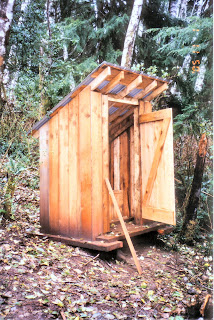On a remote or recreational property, figuring out the best way to dispose of waste water is important.
Indoor plumbing is generally an option, but it can be costly. All
Many of the systems available still require pumping and disposal of the waste from a holding tank. These can be great options for those living on larger islands where pumping services are available (basically any of the islands serviced by ferries where the pump trucks can easily travel on and off island); however they are not such a great option for many recreational and more remote properties. There are also filtration systems and outflow systems, all of which direct the waste somewhere else (such as gravel fields or in some cases directly out to bodies of water).
For most people when they think of cabins and remote properties, the traditional outhouse comes to mind. These are still very popular, and once established require little more than routine maintenance. Outhouses can be fun to decorate and they can range from incredibly rustic to quite fancy.
There are three waterless options for toilets that property owners can consider. These can be inside a cabin or in an outhouse-style building.
*Composting Toilets. These are toilets that use aerobic processing through composting. This is a controlled composting system that protects the surrounding environment. These are popular systems and readily available in many countries. Here is some more explanation on how they work: http://www.letsgogreen.com/how-composting-toilets-work.html
a composting toilet, in an outhouse
*Incinerating Toilets. As the name implies these toilets burn the waste. This can be done in a few ways depending on the system's design but generally the waste is reduced to an ash in a holding tank and then can be safely disposed of. This is an information sheet from 1999 created by the EPA in the US, all about incinerating toilets: https://19january2017snapshot.epa.gov/www3/npdes/www3/pubs/incinera.pdf
*Evaporating Toilets. These systems actually dry-out the waste and create a sterile, compact waste that can be safely disposed of in the trash system. There are both passive systems that require no outside electricity and systems that do require some energy input. Evaporating toilets are very low maintenance. http://www.enviroalternatives.com/toiletcua.html
Dealing with waste is one of those less fun but practical things that is part and parcel of owning off-grid properties. The good thing is that there are solutions for every budget and every lifestyle!
It's a Coastal Lifestyle ... Live It!

